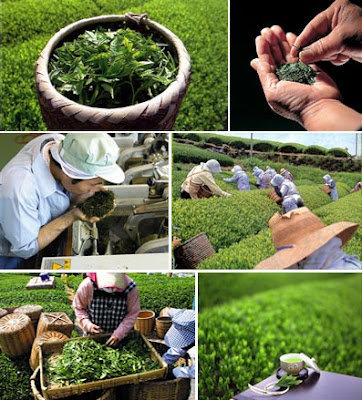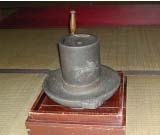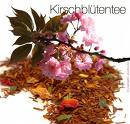::::::::::::::::::::::::::::::::::::::::::::::::::::::::::::::::::::::::::::::::::::::::::::::::::::
Tea (cha)
Various types of tea are consumed in Japan.

Hand-made tea is best !
Bancha ばん‐ちゃ(番茶) coarse tea, with a slightly smoky flavor
. . . CLICK here for Photos !
番茶も出花
Even a plain girl is pretty when she is young [sixteen].
Bancha; einfacher grüner Tee
Ganjincha, Ganjin cha 鑑真茶 "Ganjin tea"
brought from the priest Ganjin to Yamato . 大和茶粥の茶
Ganjin 鑒真 or 鑑真
The tea is used to prepare "yamato no chagayu" rice gruel with green Yamato tea.
Its base are roasted soy beans, wheat grains, hoojichaほうじ茶, hatomugi はと麦 , persimmon leaves and other ingredients.
. . . CLICK here for Photos 大和茶粥 !
Genmaicha げんまいちゃ(玄米茶) treen tea, mixture with whole rice grains
. . . CLICK here for Photos !
mit geröstetem Naturreis gemischter grüner Tee
Gyokuro ぎょくろ(玉露) green tea of the highest quality
. . . CLICK here for Photos !
Hojija, hoojicha ほうじちゃ(焙じ茶) roasted (low-grade) green tea
. . . CLICK here for Photos !
gerösteter Tee
Irima cha 入間茶 Green tea from Irima
埼玉県入間市 , Saitama prefecture

This large area provides more than 50 percent of all the green tea of Japan. They pick first tea by hand and have also varies types of machinery to cut the tea during harvest time.
kancha 寒茶 tea harvested in the cold Tokushima
Kocha, koocha 紅茶 black tea
lit. "red tea"
. . . CLICK here for Photos !
Konbucha, kombucha 昆布茶 pulverized konbu seaweeds
. . . CLICK here for Photos !
Konacha こな‐ちゃ(粉茶) powdered tea
.... kocha こちゃ
often eaten with sushi, as a palate cleanser.
Pulvertee
Kukicha くきちゃ(茎茶) made from twigs and some leaves. quite adstringent.
. . . CLICK here for Photos !
Grober Tee aus Stängeln und Blattrippen
.......................................................................
Macha, matcha 抹茶(まっちゃ)
powder from green tea leaves, for the tea ceremony.
green tea powder
Used to flavor icecream, cakes and other sweets.
. . . CLICK here for Photos !
grüner Pulvertee
- quote -
‘Matcha’ gets remake in U.S. market
by Christine Armario - April 2015 - Japan Times -
More than a thousand years ago, Buddhist monks in Japan began a daily ritual of grinding green tea leaves into powder, mixing it into hot water with a bamboo whisk, then sharing the tea from a single cup.
Today
matcha in the U.S. is considerably less monastic. It’s being blended into lattes, dusted onto cheesecakes, mixed into chocolate, even infused in bourbon. . . .
Chefs are mixing matcha with grains, using it in toppings for Bundt cakes, and mixing it into cocktails, adding a punch of opulent green color along with a cool, mellow taste to playful culinary combinations.
Teavana President Annie Young-Scrivner even uses matcha as a beauty mask.
. . . “Japan respects the traditional tea ceremony,”
said Rona Tison, a senior vice president with Ito En, one of the world’s largest green tea distributors. “But they are becoming Westernized as well.”
. . . more
- source : Japan Times
.......................................................................
Mugicha 麦茶 むぎちゃ Barley tea, usually drunk in summer.
. . . CLICK here for Photos !
Gerstentee
In Edo it was called "Mugiyu 麦湯" and drunk warm.
CLICK here for PHOTOS !
It was best in summer just after the harvest in may and june. The smell of freshly roasted grains is appetizing and even now there are a few shops in Tokyo who roast it.
marutsubu mugicha 丸粒麦茶
tsubumai 粒米

vendor of hot mugicha
source : kagome co.
::::::::::::::::::::::::::::::::::::::::::::::::::::::::::::::::::::::::::::::::::::::::::::::::::::

ochiya 御知家 o-cha
Two boxes or other containers with bancha as a wedding present in Kyushu.
The tree for a bancha plant can only be replanted once, nido to denai, does not go away for a second try, therefore auspicious in Kyushu.
Once a couple is married, it is called
"tea has been poored" お茶が入った (o-cha ga haitta).
::::::::::::::::::::::::::::::::::::::::::::::::::::::::::::::::::::::::::::::::::::::::::::::::::::
Sencha せんちゃ(煎茶) gren tea of medium-high quality. Served to guests and in restaurants.
. . . CLICK here for Photos !
Grüner Tee mittlerer Qualität
:::::::::::::::::::::::::::::::::::::::::::::::::::::::::::::::::::::::::::::::::::::::::::::::::::

Ujicha, Uji-cha 宇治茶 tea from Uji (near Kyoto)
. . . CLICK here for Photos !
Already used by Sen no Rikyu for his tea ceremony.
Shogun Ashikaga Yoshimitsu (1358–1408) promoted cultivation of green tea in the Uji area. Since that time Uji has been an important production and distribution center of superior quality green tea. Tsuen tea has been served since 1160 and is still sold in what is the oldest tea shop in Japan, and possibly the world--the Tsuen tea shop 通圓茶屋(つうえんちゃや).
The Byōdō-in, Byodo-In 平等院 with its Amida (Phoenix) Hall built in 1053, in Uji.
© More in the WIKIPEDIA !
koori uji 氷宇治(こおりうじ)Uji tea on shaved ice
kigo for all summer
Uji macha chokoreeto 宇治抹茶チョコレート
Sweets from green Uji Tea with Chocolate
chanoki ningyoo 茶の木人形 dolls carved from the tea tree
Uji Ningyoo 宇治人形, dolls from Uji

post box in Uji, in the form of an old tea caddy
At the temple Butsuryu-Ji (Butsuryuuji 仏隆寺(ぶつりゅうじ)in Uda, there is the oldest stone mortar to grind tea leaves to powder, brought by Kobo Daishi (Kukai) from China. The temple was founded by his disciple Kenne in 850. Kukai had gotten the millstone it from Emperor Tokuso 徳宗皇帝 (742 - 805). There is a kirin animal decorating one side of the millstone. The millstone was once thrown on the stone floor and broke a bit from the side, this war repaired later with pure gold, and the millstone called "Golden Millstone kin no cha-usu 金の茶臼.

Kobo Daishi also brought tea plants, which grow here.
chausu, cha-usu 茶臼 millstone for grinding tea leaves
:::::::::::::::::::::::::::::::::::::::::::::::::::::::::::::::::::::::::::::::::::::::::::::::::::
Nihoncha Instructor Association
日本茶インストラクター協会
Nihoncha Instructor (or Japanese Tea Instructor) is a certification program offered by Nihoncha Instructor Association in Japan to help promote education and consumption of Japanese Tea. This program is rather standardised teaching the most popular Japanese green tea. Sencha is most commonly studied and many of the regional differences are standardised to teach one basic method. It is a good starting point for instructors to begin their career as tea professionals, and also getting general public more deeply interested in Japanese green tea so that they start to explore different types and regions.
The Nihoncha Instructor Exam is comprised of 10 chapters, which come from Nihoncha Instructor Textbook.
1-History of Tea (mostly in Japan and China, some European history),
2-Tea Cultivation,
3-Tea Processing,
4-Other uses of Tea,
5-Chemistry of Tea,
6-Tea Preparation,
7-Health Benefit,
8-Business and Distribution of Tea,
9-Quality Examination and Judging,
10-Instruction Techniques
Currently these programs are only offered in Japanese.
http://www.nihoncha-inst.com/
:::::::::::::::::::::::::::::::::::::::::::::::::::::::::::::::::::::::::::::::::::::::::::::::::::
Cha and Cha no Yu / TEA, the Way of Tea
Tea Ceremony Saijiki
茶道の歳時記
:::::::::::::::::::::::::::::::::::::::::::::::::::::::::::::::::::::::::::::::::::::::::::::::::::::
Green tea is a popular beverage in Japan, and many people consume green tea on a daily basis. It's said that green tea was introduced to Japan in the 8th century by Buddhist monks who came back from China. Nowadays, green tea leaves are grown in many regions, including Shizuoka, Kyoto, Fukuoka, Saitama, and lots more. Especially, Uji-cha produced in Kyoto Uji region is well-known as a high grade green tea. Also, Uji region is a popular tourist destination as Ujigami Shrine and Uji Byodoin Temple are inscribed on UNESCO's World Heritage List. If you have a plan to visit Kyoto, here is a suggested itenerary to enjoy green tea.
more
Japanese tea is called o-cha and is referred to green tea. Green tea is one of the most popular beverages in Japan. Green tea harvest starts around May 1 every year in Japan. Green tea farms are filled with bright green tea leaves. Shizuoka prefecture produces most of the green tea in Japan. You can see many green tea farms around the area.
Tea leaves are steamed, dried, rolled, and blended at tea processing factory. There are many varieties of green tea. Gyokuro is the most superior green tea which has sweet flavor. As it is grown, it is protected from direct sunlight. Sencha is the most common green tea. It is raised without cover for the sun. Maccha is made by grounding steamed dried tea leaves into powder with a stone mortar. It is used for tea ceremonies. Houjicha is made by roasting the leaves. It contains little caffein or tannin. Bancha is rough tea. It is made from lower grade tea leaves and is inexpensive.
When brewing green tea, we put tea leaves in a teapot called Kyusu and pour hot water in it. Then, tea is served in an individual cup called Yunomi which has no handles. If you are visiting someone's house or business in Japan, you will probably be offered a cup of green tea. Also, Japanese restaurants serve green tea free of charge. When you drink Japanese tea, hold the yunomi cup with one hand and put the other hand at the bottom of the cup. Please remember that green tea is drunk hot and without sugar or cream.
and more !
source : gojapan.about.com / Shizuko Mishima
::::::::::::::::::::::::::::::::::::::::::::::::::::::::::::::::::::::::::::::::::::::::::::::::::::
. kuwa cha , kuwacha 桑茶 mulberry tea
kuwa no hacha 桑の葉 茶 tea from mulberry leaves
The leaves are later prepared as a kind of tsukudani and eaten, over a bowl of white rice.
. . . . . and
mulberry sake 桑酒 kuwazake , kuwashu
Made from mulberries. "Mulberry wine".
Another medicine type is also made with the bark and roots of the tree.
::::::::::::::::::::::::::::::::::::::::::::::::::::::::::::::::::::::::::::::::::::::::::::::::::::
. Saga Tenno 嵯峨天皇 (786–842)
According to legend,he was the first Japanese emperor to drink tea.
He was a great sponsor of Kukai Kobo Daishi.
Sakuracha, sakura-cha 桜茶 cherryblossom tea

Kirschblütentee
::::::::::::::::::::::::::::::::::::::::::::::::::::::::::::::::::::::::::::::::::::::::::::::::::::
Tea Poetry
The first and ONLY poetry book on the subject of tea. Included are poems from around the world and from the third through the twenty-first centuries. Compiled by TEA's editor Pearl Dexter.
TEA a magazine
A consumer quarterly magazine all about tea, both as a beverage and for its cultural significance in art, music, literature, history, and society.
source : teamag.com/
*****************************
Worldwide use
*****************************
Things found on the way
Japanese Tea Culture
(External LINKS)
Bancha (coarse tea) tells history of tea culture in Japan
Tea of Hachijuhachiya (88th night)
Awabancha & Goishicha in Tosa prefecture
Furicha
Botebote cha from Izumo region
Tea- For eating powdered grain
Chashi and Hands Processing of Making Tea
Origin of Ochazuke
The origin of "tea color"
Chakiribushi
"Ocha no ko saisai"-That's piece of cake
"Ocha wo nigosu"
Where the song "Zuizuizukkorobashi" came from?
Lucky tea of the New Year
Marriage and Tea
Funeral and Tea
Chado and Chaya
source : World Green Tea Association / www.o-cha.net
Reference : 日本各地の銘茶
Washoku Library
Akaishi meicha 赤石銘茶 あかいしめいちゃ
Asamiyacha 朝宮茶 あさみやちゃ, Shiga
Asahina gyokuro 朝比奈玉露 あさひなぎょくろ, Okabe County, Shizuoka pref.
The gyokuro leaves are carefully protected from direct sunlight by using straw or synthetic fibers. Compared to tea leaves grown in the open air, gyokuro leaves have a certain gloss and they are succulent, as well as supple and aromatic.
Ashikubocha 足久保茶 あしくぼちゃ, Shizuoka
Iinancha 飯南茶 いいなんちゃ, Mie
Ibicha 揖斐茶 いびちゃ, Gifu
Irokawacha 色川茶 いろかわちゃ, Nara
Inbicha 因尾茶 いんびちゃ, Oita
Ureshinocha 嬉野茶 うれしのちゃ, Saga
Eicha 頴娃茶 えいちゃ,Kagoshima
Oodaicha 大台茶 おおだいちゃ, Mie
Okukujicha 奥久慈茶 おくくじちゃ, Ibaragi
Kaoruhadacha 香肌茶 かおるはだちゃ, Mie
Kameyamacha 亀山茶 かめやまちゃ, Mie
Kumacha 久万茶 くまちゃ, Ehime
Kesencha 気仙茶 けせんちゃ, Iwate
Sarushimacha 猿島茶 さしまちゃ , Ibaraki
Shirakawacha 白川茶 しらかわちゃ,Gifu
Shinguucha 新宮茶 しんぐうちゃ, Ehime
Shinshirocha 新城茶 しんしろちゃ, Aichi
Suizawacha 水沢茶 すいざわちゃ, Mie
Suzukacha 鈴鹿茶 すずかちゃ, Mie
Sechiharacha 世知原茶 せちはらちゃ, Saga/Nagasaki
Senreicha 仙霊茶 せんれいちゃ, Hyogo
Takasecha 高瀬茶 たかせちゃ, Kagawa, Yamaguchi
Takemacha 岳間茶 たけまちゃ, Kumamoto
Tanbacha 丹波茶たんばちゃ, Hyogo
Chirancha 知覧茶 ちらんちゃ, Nara
Tsuchiyamacha 土山茶 つちやまちゃ, Shiga
Tosacha 土佐茶 とさちゃ, Kochi
Furuuchicha, Furu-uchi cha 古内茶ふるうちちゃ, Ibaragi
Higocha 肥後茶 ひごちゃ, Kyushu
Boochoocha 防長茶 ぼうちょうちゃ, Yamaguchi
Mandokorocha 政所茶 まんどころちゃ, Shiga
Mikawacha 三河茶 みかわちゃ, Aichi
Miyako no joocha 都城茶 みやこのじょうちゃ, Miyazaki
Mooshicha 母子茶 もうしちゃ, Hyogo
Monouchi cha 桃生茶 ものうちゃ, Miyagi, Ishimaki
Yabakeicha 耶馬溪茶 やばけいちゃ, Oita
Yabecha 矢部茶 やべちゃ, Kumamoto
Yamatocha 大和茶 やまとちゃ, Nara
Wataraicha 度会茶 わたらいちゃ, Mie
Wazukacha 和束茶 わづかちゃ, Kyoto
Nishiocha, Nishi-O cha 西尾茶 (にしおちゃ)
Nishio, Aichi
Japan’s highest quality tea leaves come from the town of Nishio, an historic tea cultivating region since the 1200s. Nishio’s idyllic climate, fresh river water, fertile soil and remoteness from major urban development foster tea leaves that are more resiliently green and nutrient than those found in any other region of Japan. Its quality is such that Nishio Matcha now represents over 60% of all Matcha sold in Japan.
The tea ceremony is very much alive in this town and children practise it at school.
The green tea is ground with stone mortars, which are driven by electical devices. Each mortar produces little tea, so more than 500 are working in one big room
The stone mortars have to be cut and cared fore by special stone masons of the ara.
:::::::::::::::::::::::::::::::::::::::::::::::::::::::::::::::::::::::::::::::::::::::::::::::::::::
. WASHOKU
Eco Products
Itoen, a Tea company 伊藤園 / 伊東園
Makes insoles for shoes out of the left-over tealeaves !
They are deodorizing and antibacterial in a natural way.
:::::::::::::::::::::::::::::::::::::::::::::::::::::::::::::::::::::::::::::::::::::::::::::::::::::
. sanbai no o-cha 三杯のお茶 / 三献茶
Three cups of tea and Ishida Mitsunari 石田三成
*****************************
HAIKU

茶の花に隠んぼする雀哉
cha no hana ni kakurenbo suru suzume kana
playing hide-and-seek
in tea blossoms ...
sparrows
川霧のまくしかけたり茶つみ唄
kawa kiri no makushikaketari cha tsumi uta
in the river fog
a boistrous noise...
tea-picking song
ぶつぶつと大念仏でつむ茶哉
butsu-butsu to oonembutsu de tsumu cha kana
grumbling praise
to Amida Buddha...
tea picker
Kobayashi Issa
Tr. David Lanoue
cha no hana 茶の花 (ちゃのはな) tea blossoms
kigo for early winter
chatsumi uta 茶つみ唄 song of the tea pickers
kigo for late spring
:::::::::::::::::::::::::::::::::::::::::::::::::::::::::::::::::::::::::::::::::::::::::::::::::::::
木隠れて茶摘みも聞くやほととぎす
kogakurete chatsumi mo kiku ya hototogisu
hidden by the shrubs
do the tea pickers hear it too?
this hototogisu
Tr. Gabi Greve
Written on the 8th day of the 5th lunar month 1694
元禄7年5月8日
Basho had spent a night at the home of Kashiwagi Soryuu 柏木素竜 (? - 1716).
Basho wrote this most probably as a response to a poem by Soryu, and described this scene from his memory of the tea plantatios of Suruga.
The ladies picking tea are coming in and out of the tea shrubs, while the hototogisu is singing his song.
. WKD : hototogisu ホトトギス, 時鳥 .
Little Cuckoo, Cuculus poliocephalis
hidden in the bushes,
do the tea-pickers too hear it?
cuckoo
Tr. Barnhill
hidden in the bushes
tea-pickers listen too -
the mountain cuckoo
Tr. John Carley (fb)
Hiding itself among the trees
Tea pickers also hear its call?
A little cuckoo.
Tr. Nelson / Saito
. Matsuo Basho 松尾芭蕉 - Archives of the WKD .
:::::::::::::::::::::::::::::::::::::::::::::::::::::::::::::::::::::::::::::::::::::::::::::::::::::
autumn is coming -
the red and green
of Japan
. LOOK HERE ! .
*****************************
Related words
Chocolate with green powered macha tea 抹茶チョコレート
chanoki ningyoo 茶の木人形 dolls carved from the tea tree
aroe cha アロエお茶 aloe tea from Aloe vera
***** WASHOKU : DRINKS SAIJIKI
***** . Matsuo Basho 松尾芭蕉 - Archives of the WKD .
Drinking Tea with Basho
:::::::::::::::::::::::::::::::::::::::::::::::::::::::::::::::::::::::::::::::::::::::::::::::::::::
[ . BACK to DARUMA MUSEUM TOP . ]
[ . BACK to WORLDKIGO . TOP . ]
:::::::::::::::::::::::::::::::::::::::::::::::::::::::::::::::::::::::::::::::::::::::::::::::::::::




